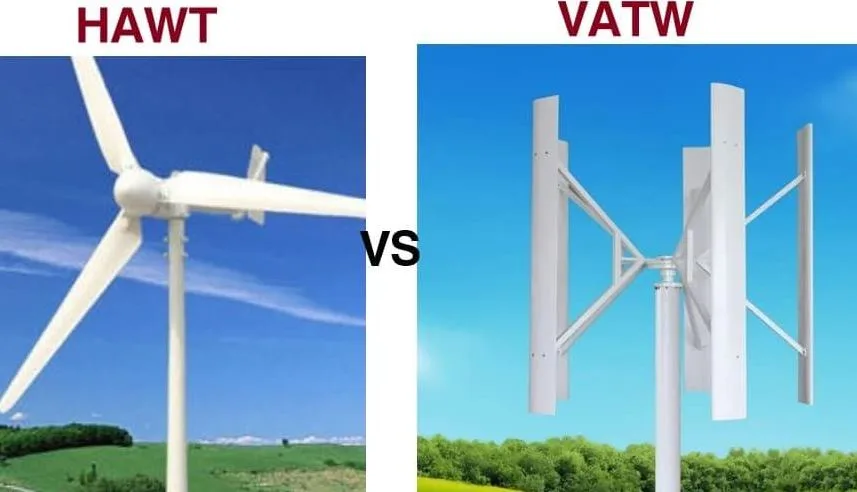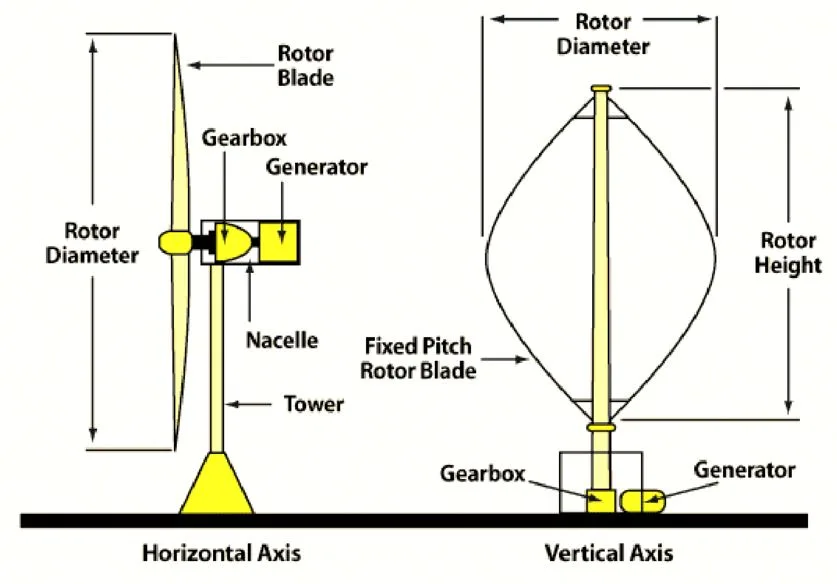In this article we will discuss about Comparison of Horizontal & Vertical Wind Turbines. Wind turbines vary in size and design, with the primary variation being axis orientation (horizontal or vertical). Obviously, in a horizontal axis wind turbine, a vertical propeller rotates horizontally, but in a vertical axis wind turbine, blades spin vertically around a vertical axis.

Years of testing revealed that horizontal axis wind turbines, or HAWTs, operate well in open settings, whereas VAWTs have fewer limits and can thus be erected on hilltops and rooftops in urban areas.
Table of Contents
Comparison of Horizontal & Vertical Wind Turbines
General Overview of HAWT & VAWT
Wind direction is critical for HAWTs because blades are more productive when the wind flows at the proper angle. They also typically include a rotation drive that allows the blades to be adjusted to the wind direction.

A vertical axis wind turbine, on the other hand, is less dependent on wind angle and can run at a lower wind speed than a typical HAWT. However, there are a few horizontal axis wind turbine designs, such as TBHAWT Manufacturing’s wind turbine, that manage to avoid efficiency loss by being built to be functional even at wind speeds of 8 m/sec or less.
Vertical axis wind turbines are vertical or perpendicular to the ground and convert wind from all directions. VAWTs, which are ideal for urban areas, can also be employed in places with unpredictable winds or in difficult rural areas.
Despite these facts, VAWTs appear less productive than HAWTs due to reduced operational speed and hence output, but they are an excellent solution for a single home with strong turbulence winds.
Small HAWTs and VAWTs produce less than 100 kW of electricity and are generally used locally for residential requirements. However, certain HAWT designs with more above 50 kW output have shown to be viable due to a solid mix of cost-effectiveness and client reach.
Small wind turbines are more popular than large ones since they require less land and investment. Small WTs are ideal for isolated and off-grid locations, and they can be linked or disconnected from national power lines.
Horizontal Axis Wind Turbine (HAWT)

Horizontal axis wind turbines harness wind energy by directing it via blades that are parallel to the ground. HAWT confronts the wind perpendicularly, causing wind turbine blades to revolve in response to aerodynamic lift.
Horizontal axis WTs dominate the wind energy industry because their construction design enables for more energy to be obtained through full rotation of the blades in terms of continuous wind flow. Furthermore, horizontal axis wind turbines resist backtracking, which is advantageous in this sort of power generation.
Horizontal axis wind turbines must be situated in the wind direction to get maximum efficiency. When the wind direction changes, energy generation efficiency might suffer dramatically.
However, when a horizontal axis wind turbine farm is placed in a correctly selected area with steady, same-directional wind flow, this disadvantage is eliminated.
A wind vane is commonly used to align a tiny wind turbine with the wind direction, whereas a yaw metre is used to rectify the wind turbine position in order to remain aligned with the wind stream. When an operator is searching for a cost-effective solution, it is critical to have consistent, stable wind flow.
Vertical Axis Wind Turbine (VAWT)

The blades of a vertical axis wind turbine revolve perpendicular to the ground and around the vertical axis in order to operate by utilising drag and lift effects. Despite their unpopularity in comparison to HAWTs, VAWTs can receive and process wind from any direction, making them ideal for urban and suburban regions with turbulent, unpredictable winds.
The gearbox and some of the wind turbine’s equipment can be located closer to the ground. By doing so, a wind turbine user can greatly reduce maintenance costs, which, along with less noisy construction, leads to improved co-living conditions.
Vertical axis wind turbines are extremely susceptible to backtracking because the blades rotate in the wind direction while needing to travel back into the wind stream before being driven around.
At the end of the day, new study indicates that vertical axis wind turbines are not much different from horizontal axis wind turbines – wind turbine efficiency is heavily dependent on the region wind conditions and necessary power generation output volume.
Rotation
HAWT blades experience the effects of variable inertial force and ever-stable gravity while rotating. HAWT blades are subjected to an alternating load as a result of these factors, which is damaging to the blade fatigue strength.
Because of inertial force and gravity stabilisation, the received effects of a vertical axis wind turbine are more steady during rotation. Because the load is fixed in this case, VAWT has a longer fatigue lifespan than HAWT.
Wind speed
It is well knowledge that horizontal axis wind turbines function well due to their high beginning speed and constant wind flow. However, it should be noted that wind turbine efficacy is heavily influenced by construction design.
China Aerodynamics Research and Development Center conducted an experiment using a tiny horizontal-axis wind turbine with a starting speed of roughly 5 m/s and a maximum receiving speed of 5.9 m/s to support this hypothesis.
The experiment demonstrated that this beginning speed is insufficient to outperform the wind turbine’s energy consumption and so is unacceptable. At the same time, other wind turbines with a wider wind speed range, such as the WTW-55 by TBHAWT Manufacturing listed above, are a more promising commercial wind turbine.
Vertical axis wind turbines are less productive since they start at a lower wind speed. H-structure vertical axis wind turbines should be chosen to produce cost-effective output; in this instance, an operator must ensure that the airfoil and optimal installation angle are adhered to precisely. An H-structured wind turbine will start at an unbeatable 2 m/s as a result.
Efficiency
Horizontal axis wind turbines dominate the wind energy market due to their significantly better efficiency as compared to VAWT. HAWTs, in turn, are divided into large and small wind turbines, with large WTs requiring large open spaces, ideally with access to the coastline to get more wind.
Small wind turbines have less restrictions and can be utilised to power small domestic dwellings as well as a community or municipality. Obviously, it all relies on the size of the wind farm; the larger it is, the more households it can service.
Horizontal axis wind turbines outperform VAWT in terms of upscaling and productivity in commercial applications. HAWT maintenance costs more because they are larger, but they produce 10 times more electricity than a typical vertical axis wind turbine.
Vertical axis wind turbines are significantly inefficient in high-speed wind flows because of their ultimately low starting torques and dynamic stability concerns.
Both horizontal and vertical axis wind turbines have advantages and disadvantages. To get the most out of it, a developer must first select whether they want to self-procure a wind turbine or monetize wind energy by turning wind turbines into a reliable long-term revenue.